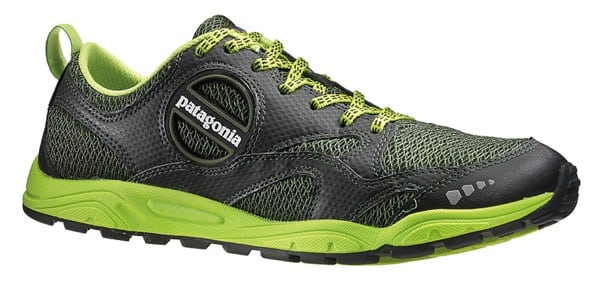Our Favorite Trail Running Shoes
Check out our Best Trail Running Shoes article to learn about our current favorite trail running shoes!
Patagonia EVERmore Review
Patagonia is best known for their rugged outdoor apparel and their environmental policies. The company also has a lineup of trail shoes, and the Patagonia EVERmore ($110) is the minimal trail shoe option. What attracted me to the EVERmore was its low profile and light weight (7.8 ounces in men’s 9). The shoe definitely lands near the minimalist side of things with a 4mm drop. In the context of others shoes I’ve worn I found it most similar to the New Balance MT110, but with a stiffer and a more rugged feel, despite almost identical weights.

The Patagonia EVERmore.
Upper
The EVERmore fits within Patagonia’s usual offerings as the upper has a very heavy-duty feel. The leather toe bumper seems to pretty good job when it comes keeping the toes protected from rocks and roots. The rest of the toe box is constructed with air-mesh layers and structural overlays. I’m semi-concerned about tearing through the mesh layer as I’ve already worn the outermost layer near the inner big toe mound. I have done this with other shoes in the past, but this started happening after only around 40 miles, so I will see how it holds up.
I found that water drainage was pretty efficient in creek-crossing tests. One problem I had with the upper was that the lacing system was a little hard to work with. Tightening the fit wasn’t a problem, but trying to loosen the laces took a little work to push the laces back through the lace holes and the laces were a little short for me. I did feel that the upper kept my foot secure once I was able to get my lace tension correct.
Midsole
The EVERmore has an EVA midsole with a 17/13mm stack height. I’ve preferred shoes with a 4mm drop like the EVERmore for a few years so the heel-toe differential felt normal but is worth noting if trying minimal shoes for the first time. One of the biggest midsole concerns was the narrowness of the arch of the shoe. My foot, which fits fine in most shoes, felt confined and given too much support in the arch. This caused some rubbing issues when I wore the shoes without running socks and got them wet. The shoe was designed for use barefoot or with a light sock so I would recommend a light pair of socks when first breaking in the shoe and if you anticipate getting wet.
While the Patagonia website claims that the EVERmore midsole is soft flexing, I found the midsole to be rather stiff. That took me a little while to get used to when first trying the shoe. I think that a combination of the shoe getting broken in and me getting used to it led me to me to no longer be concerned about the issue.
The EVERmore was true to the high-rebound claim. I found that some of the shoes’ best performance came through when I was moving at a decent clip along the trail. The shoe gives good energy return when the trail is packed down tight. I felt that softer trails and mud dampened the feature. There is a forefoot rock plate in the shoe that seemed to do its job well anytime I stepped on sharp rocks.
Outsole
The outsole was adequate in most of the trail settings I tested. The outsole of the EVERmore is composed of Patagonia’s EVERtough rubber with forward-facing climbing lugs and rear-facing braking lugs for descents. The outsole performed best when navigating rocks and dry trail. I didn’t feel as confident in the outsole was when I found myself running in snow or mud. The lugs were just a little too big for these conditions and didn’t provide as much traction as I would have liked. Also, caked mud stuck to the bottom of the shoe for some time. The wider forefoot of the outsole gave the EVERmore a really nice, stable feel and some protection from potential ankle rolling.

The EVERmore’s outsole.
Overall
I was fortunate enough to test the Patagonia EVERmore during the transition from winter to spring so I have had the opportunity to test the shoes on everything from packed dirt and snow to mud and fresh powder. I found the performance of the shoe was best on dry or hard-packed trail with good road crossover, as well. In normal trail conditions, the shoe does a solid job of providing protection from the trail without encumbering the foot with bulk. I enjoyed the light weight of the shoes and high-rebound feel of the midsole, and the EVERmore shined when I was moving quickly on the trail. The shoe does work in muddy and snowy conditions, but there are shoes out there that do a better job in those situations.
Depending on the runner I could see this shoe functioning as an everyday trainer, a shorter distance trail racing shoe, or a minimal foot-strengthening tool. I think the shoe would work very well when doing faster-paced workouts on the trail.
